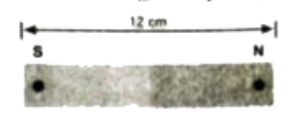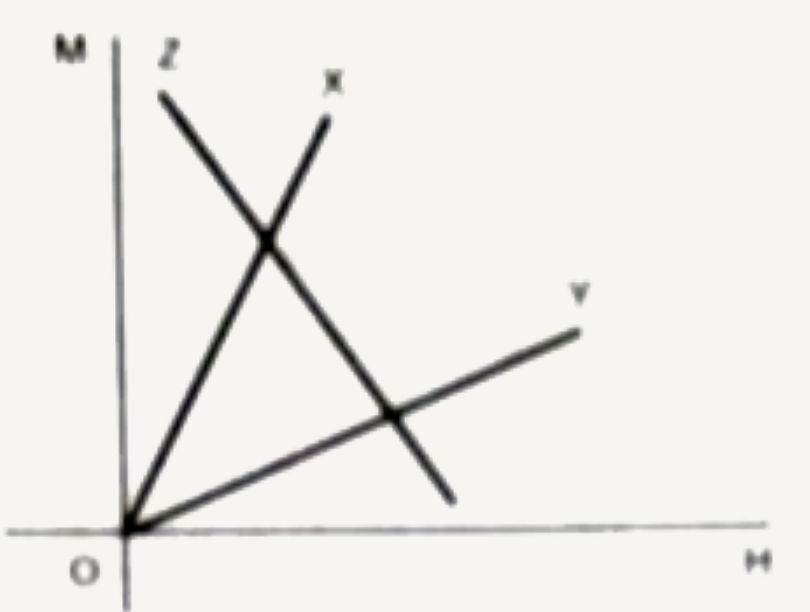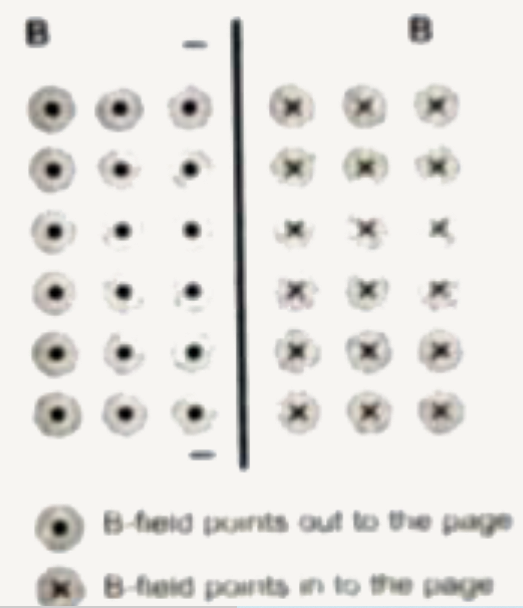Complete Solutions to IN -TEXT SOLVED EXAMPLES of chapter MAGNETISM AND MAGNETIC EFFECTS OF ELECTRIC CURRENT of Class 12 book with complete answers and questions
| Class 12 | PHYSICS |
| Chapter | MAGNETISM AND MAGNETIC EFFECTS OF ELECTRIC CURRENT |
| FULL MARKS | IN -TEXT SOLVED EXAMPLES |
| Number Of Questions | 30 |
| Academic Year | 2023-24 |
The horizontal component and vertical components of Earth's maganetic field at a plase are 0.15 G and 0.26 G respectively. Calculate the angle of dip and resultant magnetic field.
03:25View SolutionLet the magnetic moment of a bar magnet be `vec(p_(m))` whose mangetic length is d = 2l and pole strenght is `q_(m)`. Compute the magnetic moment of the bar magnet when it is cut into two pieces.
(a) along its length (b) perpendicular to its length02:22View SolutionCompute the magnetic length of a uniform bar magnet if the geometrical length of the magnet is 12 cm. Mark the positions of magnetic pole points.
 02:44View Solution
02:44View SolutionCalculate the magnetic flux coming out from the surface containing magnetic dipole ( say, a bar magnet ) as shown in figure.
 View Solution
View SolutionThe repulsive force between two magnetic poles in air is `9 xx 10^(-3)` N. if the two poles are equal in strength and are separated by a distance of 10 cm , calculate the pole strength of each pole .
02:54View SolutionA short bar magnet has a magnetic moment of 0.5 J `T^(-1)`. Calculate magnitude and direction of the magnetic field produced by the bar magnet which is kept at a distance of 0.1 m from the centre of the bar magnet (a) axial line of the bar magnet and (b) normal bisector of the bar magnet.
04:03View SolutionShow the time period of oscillation when a bar magnet is kept in a uniform magnetic field is T = `2pi sqrt((l)/(p_(m)B))` . In second, where I represents moment of inertia of the bar magnet, `p_(m)` is the magnetic moment and is the magnetic field.
04:08View SolutionConsider a magnetic dipole which on switching ON external magnetic field orient only in two possible was i.e., one along the direction of the magnetic field (parallel to the field ) and another anti-parallel to magnetic field. Compute the energy for the possible orientation . Sketch the graph.
03:35View SolutionA coil of a tangent galvanometer of diametre 0.24 m has 100 turns. If the horizontal component of Earth's magnetic field is `25 xx 10^(-6)` T then, calculate the current which gives a deflection of `60^(@)` .
02:44View SolutionCompute the intensity of magnetisation of the bar magnet whose mass, magnetic moment and density are 200 g. 2 A `m^(2)` and 8 g `cm^(-3)`,respectively.
05:11View SolutionUsing the relation `vec(B) = mu_(0) (vec(H)+ vec(M))`, show that `X_(m) = mu_(r) - 1`.
02:46View SolutionTwo materials X and Y are magnetised, whose intensity of magnetisation are 500 A `m^(-1)` and 2000 `A m^(-1)`, respectively. If the magnetising field is 1000 A `m. then which one among these materials can be easily magnetized ?
03:02View SolutionThe following figure shows the variation of intensity of magnetisation with the applied magnetic field intensity for three magnetic materials X, Y and Z. Identify the materials X, Y and Z.
 04:24View Solution
04:24View SolutionThe magnetic field shown in the figure is due to the current carrying wire, In which direction does the current flow in the wire ?
 02:02View Solution
02:02View SolutionCalculate the magnetic field at a point P which is perpendicular bisector to current carrying straight wire as shown in figure.
 View Solution
View SolutionShow that for a straight conductor , the magnetic field.
 View Solution
View SolutionWhat is the magnetic field at the centre of the loop shown in figure ?
 View Solution
View SolutionCompute the magnetic of the magnetic field of a long, straight wire carrying a current of 1 A at distance of 1m from it. Compare it with Earth's magnetic field .
02:26View SolutionCalculate the magnetic field inside a solenold ,when
(a) The length of the solenoid becomes twice and fixed number of turns
(b) both the length of the solenoid and number of turns are double
(c ) the number of turns becomes twice for the fixed length of the solenoid compare the results,04:09View SolutionA particle of charge q moves with velocity `vec(v)` along positive y - direction in a magnetic field `vec(B)`. Compute the Lorentz force experienced by the particle (a) when magnetic field is along positive y-direction (b) when magnetic field points in positive z -direction (c ) when magnetic field is in zy - plane and making an angle `theta` with velocity of the particle. Mark the direction of magnetic force in each case.
08:28View SolutionCompute the work done and power delivered by the Lorentz force on the particle of charge q moving with velocity `vec(v)`. Calculate the angle between Lorentz force and velocity of the charged particle and also interpret the result.
05:32View SolutionAn electron moving perpendicular to a uniform magnetic field 0.500 T undergoes circular motion of radius 2.80 mm. What is the speed of electron ?
03:28View SolutionA Proton moves in a iniform magnetic field of strength 0.500 T magnetic field is directed along the x-axis . At initial time, t = 0 s, the proton has velocity `vec(v) = (1.95 xx 10^(5) hat(i) + 2.00 xx 10^(5) hat(k) ) ms^(-1)`. Find
(a) At initial time, what is the acceleration of the proton
(b) is the path circular or helical , calculate the radius of helical trajectory and also calculate the pitch of the helix (Note: Pitch of the helix is the distance travelled along the helix axis per revolution ).07:56View SolutionTwo singly ionized isotopes of uranium `(235)/(92) U and (238)/(92)`U (isotopes have same atomic number but different mass number ) are sent with velocity 1.00 `xx 10^(5) m s^(-1)` into a magnetic field of strength 0.500 T normally . Compute the distance between the two isotopes after they complete a semi-circle. Also compute the time taken by each isotope to complete one semi-circular path. (given : masses of the isotopes :
 View Solution
View SolutionLet E be the electric field of magnitude 6.0 `xx 10^(6) N C^(-1)` and B be the magnetic field magnitude 0.83 T. Suppose an electron is accelerated with a potential of 200 V, will it show zero deflection ? If not, at what potential will it show zero deflection .
04:53View SolutionSuppose a cyclotron is operated to accelerate protons with a magnetic field of strength 1 T. Calculate the frequency in which the electric field between two Dees could be reversed .
02:06View SolutionA metallic rod of linear density is 0.25 kg `m^(-1)` is lylong horizontally on a smooth inclined plane which makes an angle of `45^(@)` with the horizontal. The rod is not allowed to slide down by flowing a current through it when a magnetic field of strength 0.25 T is acting on it in the vertical direction. Calculates the electric current flowing in the rod to keep it stationary .
03:44View SolutionConsider a circular wire loop of radius R, mass kept at rest on a rough surface . Let 1 be the current flowing through the loop and `vec(B) ` be the magnetic field acting along horizontal as shown in Figure. Estimate the current I that should be applied so that one edge of the loop is lifted off the surface ?
 04:59View Solution
04:59View SolutionThe coil of a moving coil galvanometer has 5 turns and each turn has an effective area of `2 xx 10^(-2) m^(2)` . It is suspended in a magnetic field whose strength is `4 xx 10^(-2)` Wb `m^(-2)` . If the torsional constant K of the suspension fibre is ` 4xx 10^(9)` N m `deg^(-1)` .
(a) Find its current sensitivity in degree per micro - ampere
(b) Calculate the voltage sensitivity of the galvanometer for it to havefull scale deflection of 50 divisions for 25 mV.
(c ) Compute the resistance of the galvanometer .04:23View SolutionThe resistance of moving coil galvanometer is made twice its original value in order to increase current sensitivity by 50% Will the voltage sensitivity change ? If so, by how much?
03:48View Solution
IN -TEXT SOLVED EXAMPLES questions and complete solutions for chapter MAGNETISM AND MAGNETIC EFFECTS OF ELECTRIC CURRENT of FULL MARKS PHYSICS (TAMIL ENGLISH) of Class 12
All Exercises from FULL MARKS Class 12 PHYSICS MAGNETISM AND MAGNETIC EFFECTS OF ELECTRIC CURRENT
- ADDITIONAL QUESTIONS SOLVED
- ADDITIONAL QUESTIONS SOLVED - 3-MARK QUESTIONS
- ADDITIONAL QUESTIONS SOLVED - 5-MARK QUESTIONS
- ADDITIONAL QUESTIONS SOLVED - III. MATCH THE FOLLOWING :
- ADDITIONAL QUESTIONS SOLVED - NUMERICAL PROBLEMS :
- ADDITIONAL QUESTIONS SOLVED -2-MARK QUESTIONS
- ADDITIONAL QUESTIONS SOLVED -ASSERTION AND REASON QUESTIONS :
- ADDITIONAL QUESTIONS SOLVED -III. FILL IN THE BLANKS :
- IN -TEXT SOLVED EXAMPLES
- TEXT EVALUATION SOLVED
- TEXT EVALUATION SOLVED - LONG ANSWER QUESTIONS
- TEXT EVALUATION SOLVED - NUMERICAL PROBLEMS
- TEXT EVALUATION SOLVED -SHORT ANSWER QUESTIONS
